Comparison of Spatially and Nonspatially Explicit Nonlinear Mixed Effects Models for Norway Spruce Individual Tree Growth under Single-Tree Selection
Abstract
1. Introduction
2. Methods
2.1. Study Material
2.2. Data Processing
2.3. Statistical Analyses
3. Results
4. Discussion
5. Conclusions
Supplementary Materials
Author Contributions
Funding
Conflicts of Interest
References
- Mason, W. Implementing continuous cover forestry in planted forests: Experience with Sitka Spruce (Picea Sitchensis) in the British Isles. Forests 2015, 6, 879–902. [Google Scholar] [CrossRef]
- Mizunaga, H.; Nagaike, T.; Yoshida, T.; Valkonen, S. Feasibility of silviculture for complex stand structures: Designing stand structures for sustainability and multiple objectives. J. For. Res. 2010, 15, 1–2. [Google Scholar] [CrossRef]
- Kuuluvainen, T.; Tahvonen, O.; Aakala, T. Even-aged and uneven-aged forest management in Boreal Fennoscandia: A review. AMBIO 2012, 41, 720–737. [Google Scholar] [CrossRef] [PubMed]
- Curtis, R.O. Yield tables past and present. J. For. 1972, 70, 28–32. [Google Scholar]
- Pukkala, T.; Lähde, E.; Laiho, O. Species interactions in the dynamics of even- and uneven-aged Boreal Forests. J. Sustain. For. 2013, 32, 371–403. [Google Scholar] [CrossRef]
- Fekedulegn, D.; Mac Siurtain, M.; Colbert, J. Parameter estimation of nonlinear growth models in forestry. Silva Fenn. 1999, 33. [Google Scholar] [CrossRef]
- Paine, C.E.T.; Marthews, T.R.; Vogt, D.R.; Purves, D.; Rees, M.; Hector, A.; Turnbull, L.A. How to fit nonlinear plant growth models and calculate growth rates: An update for ecologists: Nonlinear plant growth models. Methods Ecol. Evolut. 2012, 3, 245–256. [Google Scholar] [CrossRef]
- Tomé, J.; Tomé, M.; Barreiro, S.; Paulo, J.A. Age-independent difference equations for modelling tree and stand growth. Can. J. For. Res. 2006, 36, 1621–1630. [Google Scholar] [CrossRef]
- Quiñonez-Barraza, G.; Zhao, D.; De Los Santos Posadas, H.M.; Corral-Rivas, J.J. Considering neighborhood effects improves individual dbh growth models for natural mixed-species forests in Mexico. Ann. For. Sci. 2018, 75, 78. [Google Scholar] [CrossRef]
- Ou, Q.; Lei, X.; Shen, C. Individual tree diameter growth models of larch–spruce–fir mixed forests based on machine learning algorithms. Forests 2019, 10, 187. [Google Scholar] [CrossRef]
- Givnish, T. Adaptation to sun and shade: A whole-plant perspective. Funct. Plant. Biol. 1988, 15, 63. [Google Scholar] [CrossRef]
- King, D.A. The adaptive significance of tree height. Am. Nat. 1990, 135, 809–828. [Google Scholar] [CrossRef]
- Assmann, E. The Principles of Forest Yield Study; Pergamon: Oxford, UK, 1970. [Google Scholar]
- Sterba, H.; Blab, A.; Katzensteiner, K. Adapting an individual tree growth model for Norway spruce (Picea abies L. Karst.) in pure and mixed species stands. For. Ecol. Manag. 2002, 159, 101–110. [Google Scholar] [CrossRef]
- Andreassen, K.; Tomter, S.M. Basal area growth models for individual trees of Norway spruce, Scots pine, birch and other broadleaves in Norway. For. Ecol. Manag. 2003, 180, 11–24. [Google Scholar] [CrossRef]
- Pukkala, T.; Lähde, E.; Laiho, O. Growth and yield models for uneven-sized forest stands in Finland. For. Ecol. Manag. 2009, 258, 207–216. [Google Scholar] [CrossRef]
- Dănescu, A.; Albrecht, A.T.; Bauhus, J.; Kohnle, U. Geocentric alternatives to site index for modeling tree increment in uneven-aged mixed stands. For. Ecol. Manag. 2017, 392, 1–12. [Google Scholar] [CrossRef]
- Bianchi, S.; Huuskonen, S.; Siipilehto, J.; Hynynen, J. Differences in tree growth of Norway spruce under rotation forestry and continuous cover forestry. For. Ecol. Manag. 2020, 458, 117689. [Google Scholar] [CrossRef]
- Oboite, F.O.; Comeau, P.G. The interactive effect of competition and climate on growth of boreal tree species in western Canada and Alaska. Can. J. For. Res. 2020, 457–464. [Google Scholar] [CrossRef]
- Pretzsch, H.; Biber, P.; Ďurský, J. The single tree-based stand simulator SILVA: Construction, application and evaluation. For. Ecol. Manag. 2002, 162, 3–21. [Google Scholar] [CrossRef]
- Lacerte, V.; Larocque, G.R.; Woods, M.; Parton, W.J.; Penner, M. Calibration of the forest vegetation simulator (FVS) model for the main forest species of Ontario, Canada. Ecol. Modell. 2006, 199, 336–349. [Google Scholar] [CrossRef]
- de-Miguel, S.; Pukkala, T.; Assaf, N.; Bonet, J.A. Even-aged or uneven-aged modelling approach? A case for Pinus brutia. Ann. For. Sci. 2012, 69, 455–465. [Google Scholar] [CrossRef]
- Thurnher, C.; Klopf, M.; Hasenauer, H. MOSES–A tree growth simulator for modelling stand response in Central Europe. Ecol. Modell. 2017, 352, 58–76. [Google Scholar] [CrossRef]
- Rohner, B.; Waldner, P.; Lischke, H.; Ferretti, M.; Thürig, E. Predicting individual-tree growth of central European tree species as a function of site, stand, management, nutrient, and climate effects. Eur. J. For. Res. 2018, 137, 29–44. [Google Scholar] [CrossRef]
- Häbel, H.; Myllymäki, M.; Pommerening, A. New insights on the behaviour of alternative types of individual-based tree models for natural forests. Ecol. Model. 2019, 406, 23–32. [Google Scholar] [CrossRef]
- Stadelmann, G.; Temperli, C.; Rohner, B.; Didion, M.; Herold, A.; Rösler, E.; Thürig, E. Presenting MASSIMO: A management scenario simulation model to project growth, harvests and carbon dynamics of Swiss forests. Forests 2019, 10, 94. [Google Scholar] [CrossRef]
- Mailly, D.; Turbis, S.; Pothier, D. Predicting basal area increment in a spatially explicit, individual tree model: A test of competition measures with black spruce. Can. J. For. Res. 2003, 33, 12. [Google Scholar] [CrossRef]
- Pommerening, A.; LeMay, V.; Stoyan, D. Model-based analysis of the influence of ecological processes on forest point pattern formation—A case study. Ecol. Model. 2011, 222, 666–678. [Google Scholar] [CrossRef]
- Pacala, S.W.; Canham, C.D.; Saponara, J.; Silander, J.A.; Kobe, R.K.; Ribbens, E. Forest models defined by field measurements: Estimation, error analysis and dynamics. Ecol. Monogr. 1996, 66, 1–43. [Google Scholar] [CrossRef]
- Coates, K.D.; Canham, C.D.; Beaudet, M.; Sachs, D.L.; Messier, C. Use of a spatially explicit individual-tree model (SORTIE/BC) to explore the implications of patchiness in structurally complex forests. For. Ecol. Manag. 2003, 186, 297–310. [Google Scholar] [CrossRef]
- Chumachenko, S.I.; Korotkov, V.N.; Palenova, M.M.; Politov, D.V. Simulation modelling of long-term stand dynamics at different scenarios of forest management for coniferous–broad-leaved forests. Ecol. Modell. 2003, 170, 345–361. [Google Scholar] [CrossRef]
- Fabrika, M. Simulátor Biodynamiky Lesa SIBYLA, Koncepcia, Konštrukcia a Programové Riešenie; Technical University in Zvolen: Zvolen, Slovakia, 2005. [Google Scholar]
- Lei, X.; Wang, W.; Peng, C. Relationships between stand growth and structural diversity in spruce-dominated forests in New Brunswick, Canada. Can. J. For. Res. 2009, 39, 13. [Google Scholar] [CrossRef]
- Wang, W.; Chen, X.; Zeng, W.; Wang, J.; Meng, J. Development of a mixed-effects individual-tree basal area increment model for oaks (Quercus spp.) considering forest structural diversity. Forests 2019, 10, 474. [Google Scholar] [CrossRef]
- Biging, G.S.; Dobbertin, M. Evaluation of competition indices in individual tree growth models. For. Sci. 1995, 41, 360–377. [Google Scholar]
- Corral Rivas, J.J.; González, J.G.Á.; Aguirre, O.; Hernández, F.J. The effect of competition on individual tree basal area growth in mature stands of Pinus cooperi Blanco in Durango (Mexico). Eur. J. For. Res. 2005, 124, 133–142. [Google Scholar] [CrossRef]
- Kuehne, C.; Weiskittel, A.R.; Waskiewicz, J. Comparing performance of contrasting distance-independent and distance-dependent competition metrics in predicting individual tree diameter increment and survival within structurally-heterogeneous, mixed-species forests of Northeastern United States. For. Ecol. Manag. 2019, 433, 205–216. [Google Scholar] [CrossRef]
- Lundqvist, L. Tamm Review: Selection system reduces long-term volume growth in Fennoscandic uneven-aged Norway spruce forests. For. Ecol. Manag. 2017, 391, 362–375. [Google Scholar] [CrossRef]
- Iqbal, I.A.; Musk, R.A.; Osborn, J.; Stone, C.; Lucieer, A. A comparison of area-based forest attributes derived from airborne laser scanner, small-format and medium-format digital aerial photography. Int. J. Appl. Earth Obs. Geoinf. 2019, 76, 231–241. [Google Scholar] [CrossRef]
- Metslaid, M.; Jõgiste, K.; Nikinmaa, E.; Moser, W.K.; Porcar-Castell, A. Tree variables related to growth response and acclimation of advance regeneration of Norway spruce and other coniferous species after release. For. Ecol. Manag. 2007, 250, 56–63. [Google Scholar] [CrossRef]
- Kuehne, C.; Weiskittel, A.R.; Wagner, R.G.; Roth, B.E. Development and evaluation of individual tree- and stand-level approaches for predicting spruce-fir response to commercial thinning in Maine, USA. For. Ecol. Manag. 2016, 376, 84–95. [Google Scholar] [CrossRef]
- Lhotka, J.M.; Loewenstein, E.F. An individual-tree diameter growth model for managed uneven-aged oak-shortleaf pine stands in the Ozark Highlands of Missouri, USA. For. Ecol. Manag. 2011, 261, 770–778. [Google Scholar] [CrossRef]
- Kuehne, C.; Russell, M.B.; Weiskittel, A.R.; Kershaw, J.A. Comparing strategies for representing individual-tree secondary growth in mixed-species stands in the Acadian Forest region. For. Ecol. Manag. 2020, 459, 117823. [Google Scholar] [CrossRef]
- Cajander, A.K. Forest types and their significance. Acta For. Fenn. 1949, 5, 7396. [Google Scholar] [CrossRef]
- Tonteri, T.; Hotanen, J.-P.; Kuusipalo, J. The Finnish forest site type approach: Ordination and classification studies of mesic forest sites in southern Finland. Vegetatio 1990, 87, 85–98. [Google Scholar] [CrossRef]
- Ahlström, M.A.; Lundqvist, L. Stand development during 16–57 years in partially harvested sub-alpine uneven-aged Norway spruce stands reconstructed from increment cores. For. Ecol. Manag. 2015, 350, 81–86. [Google Scholar] [CrossRef]
- Hynynen, J.; Eerikäinen, K.; Mäkinen, H.; Valkonen, S. Growth response to cuttings in Norway spruce stands under even-aged and uneven-aged management. For. Ecol. Manag. 2019, 437, 314–323. [Google Scholar] [CrossRef]
- Valkonen, S.; Giacosa, L.A.; Heikkinen, J. Tree mortality in the dynamics and management of uneven-aged Norway spruce stands in southern Finland. Eur. J. For. Res. 2020, 1–10. [Google Scholar] [CrossRef]
- Pommerening, A.; Stoyan, D. Edge-correction needs in estimating indices of spatial forest structure. Can. J. For. Res. 2006, 36, 1723–1739. [Google Scholar] [CrossRef]
- Hegyi, F. A simulation model for managing jack-pine standssimulation. Royal Coll. For. Res. Notes 1974, 30, 74–90. [Google Scholar]
- Aakala, T.; Fraver, S.; D’Amato, A.W.; Palik, B.J. Influence of competition and age on tree growth in structurally complex old-growth forests in northern Minnesota, USA. For. Ecol. Manag. 2013, 308, 128–135. [Google Scholar] [CrossRef]
- Hijmans, R.J.; Phillips, S.; Leathwick, J.; Elith, J. dismo: Species Distribution Modeling; R Foundation for Statistical Computing: Vienna, Austria, 2017. [Google Scholar]
- R Core Team. R: A Language and Environment for Statistical Computing; R Foundation for Statistical Computing: Vienna, Austria, 2019. [Google Scholar]
- Gini, C. Reprinted in Memorie di metodologica statistica. In Variabilità e Mutabilità (Variability and Mutability); Pizetti, E., Salvemini, T., Eds.; Libreria Eredi Virgilio Veschi: Bologna, Italy, 1912. [Google Scholar]
- Zeileis, A. ineq: Measuring Inequality, Concentration, and Poverty; R Foundation for Statistical Computing: Vienna, Austria, 2014. [Google Scholar]
- Venäläinen, A.; Tuomenvirta, H.; Pirinen, P.; Drebs, A. A Basic Finnish Climate Data Set 1961–2000-Description and Illustrations; Finnish Meteorological Institute: Helsinki, Finland, 2005; p. 27.
- Pinheiro, J.; Bates, D.; DebRoy, S.; Sarkar, D.; R Core Team. nlme: Linear and Nonlinear Mixed Effects Models; R Foundation for Statistical Computing: Vienna, Austria, 2019. [Google Scholar]
- Calama, R.; Montero, G. Interregional nonlinear height-diameter model with random coefficients for stone pine in Spain. Can. J. For. Res. 2004, 34, 21. [Google Scholar] [CrossRef]
- Kiernan, D.H.; Bevilacqua, E.; Nyland, R.D. Individual-tree diameter growth model for sugar maple trees in uneven-aged northern hardwood stands under selection system. For. Ecol. Manag. 2008, 256, 1579–1586. [Google Scholar] [CrossRef]
- Bennett, N.D.; Croke, B.F.W.; Guariso, G.; Guillaume, J.H.A.; Hamilton, S.H.; Jakeman, A.J.; Marsili-Libelli, S.; Newham, L.T.H.; Norton, J.P.; Perrin, C.; et al. Characterising performance of environmental models. Environ. Modell. Softw. 2013, 40, 1–20. [Google Scholar] [CrossRef]
- Kuusinen, N.; Valkonen, S.; Berninger, F.; Mäkelä, A. Seedling emergence in uneven-aged Norway spruce stands in Finland. Scand. J. For. Res. 2019, 34, 200–207. [Google Scholar] [CrossRef]
- Pommerening, A.; Maleki, K. Differences between competition kernels and traditional size-ratio based competition indices used in forest ecology. For. Ecol. Manag. 2014, 9, 135–143. [Google Scholar] [CrossRef]
- Yu, X.; Hyyppä, J.; Vastaranta, M.; Holopainen, M.; Viitala, R. Predicting individual tree attributes from airborne laser point clouds based on the random forests technique. ISPRS J. Photogramm. Remote Sens. 2011, 66, 28–37. [Google Scholar] [CrossRef]
- Tompalski, P.; Coops, N.; Marshall, P.; White, J.; Wulder, M.; Bailey, T. Combining multi-date airborne laser scanning and digital aerial photogrammetric data for forest growth and yield modelling. Remote Sens. 2018, 10, 347. [Google Scholar] [CrossRef]
- Bevilacqua, E.; Puttock, D.; Blake, T.J.; Burgess, D. Long-term differential stem growth responses in mature eastern white pine following release from competition. Can. J. For. Res. 2005, 35, 10. [Google Scholar] [CrossRef]
- Stephenson, N.L.; Das, A.J.; Condit, R.; Russo, S.E.; Baker, P.J.; Beckman, N.G.; Coomes, D.A.; Lines, E.R.; Morris, W.K.; Rüger, N.; et al. Rate of tree carbon accumulation increases continuously with tree size. Nature 2014, 507, 90–93. [Google Scholar] [CrossRef]
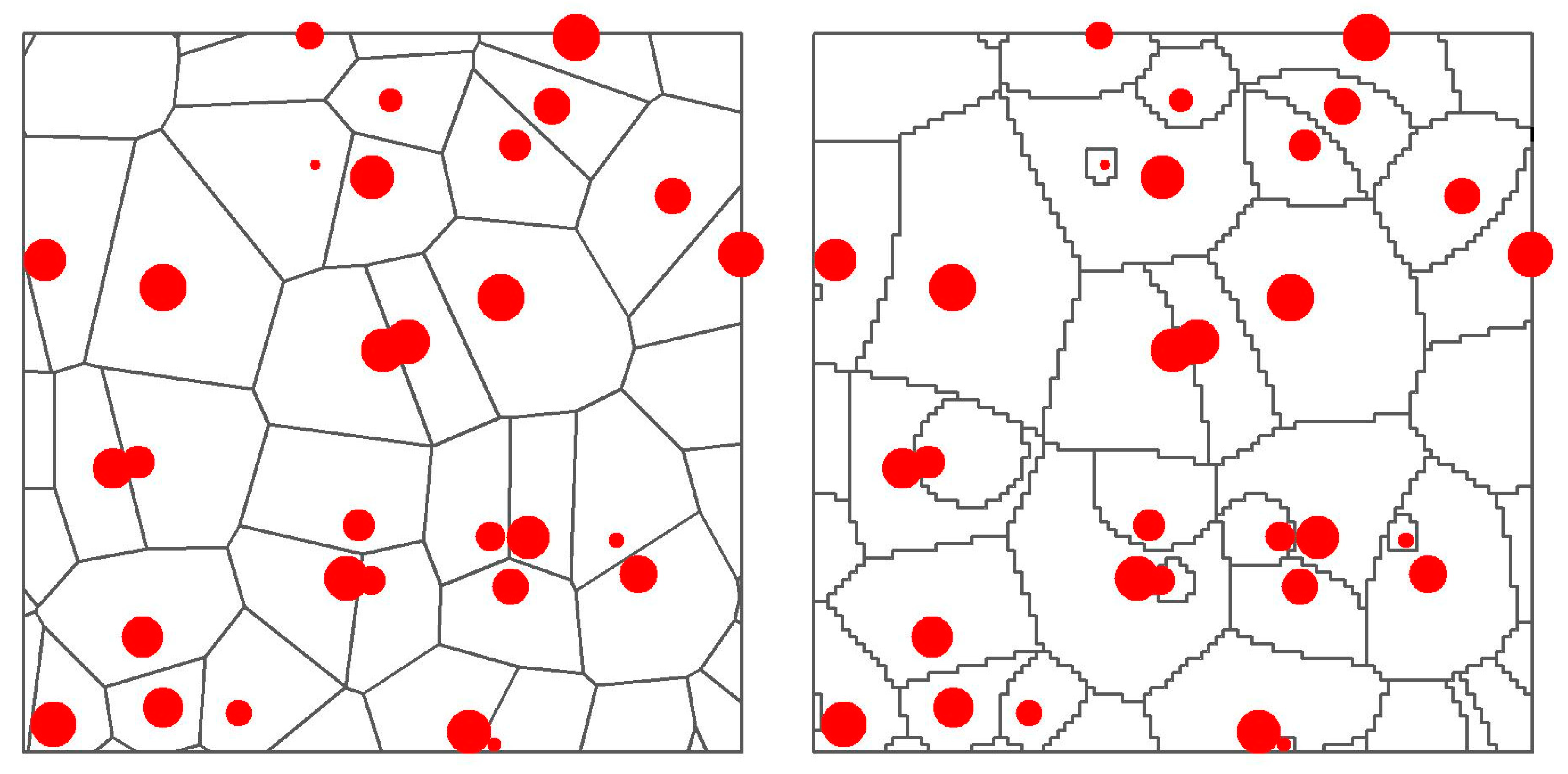
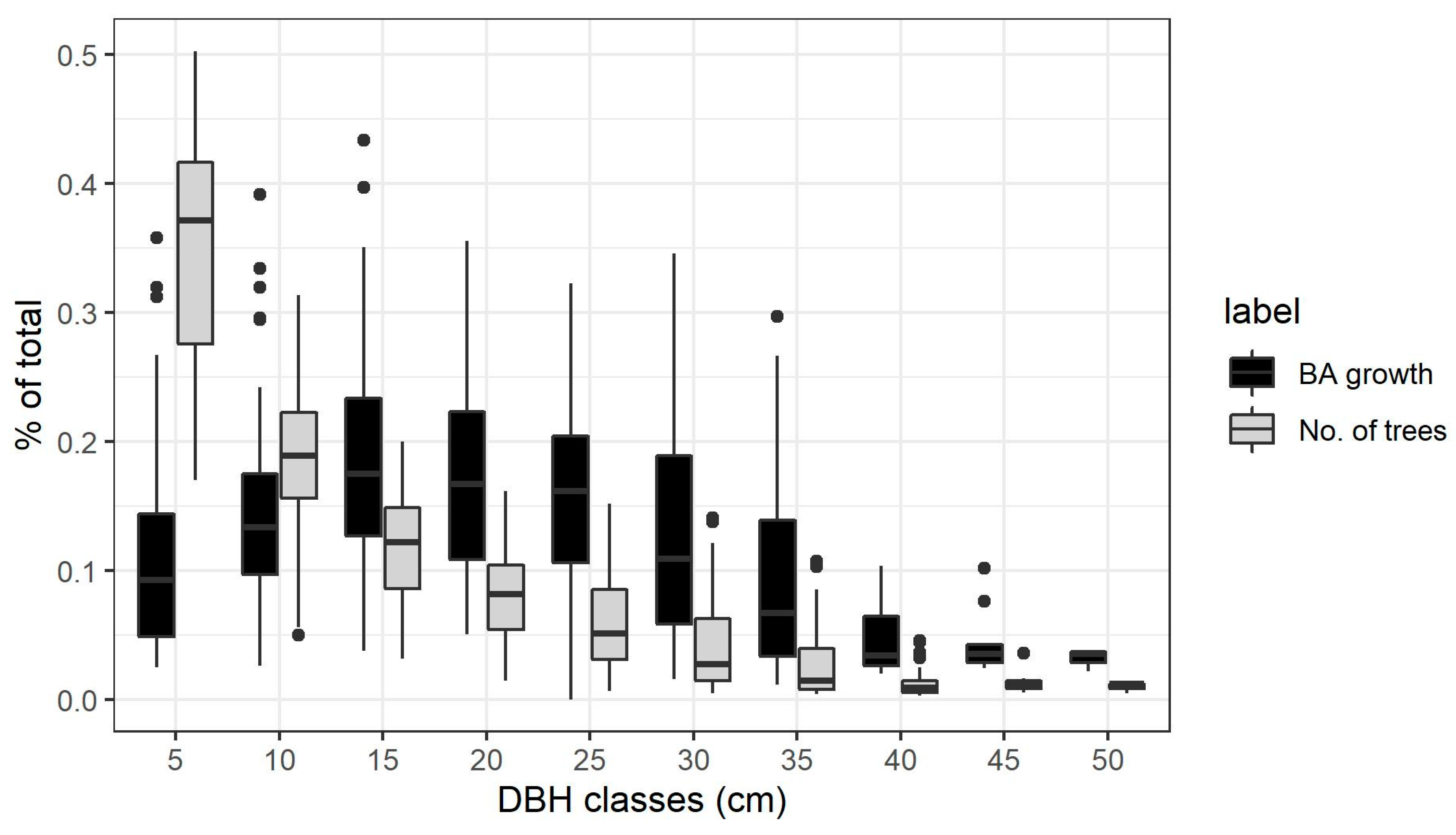
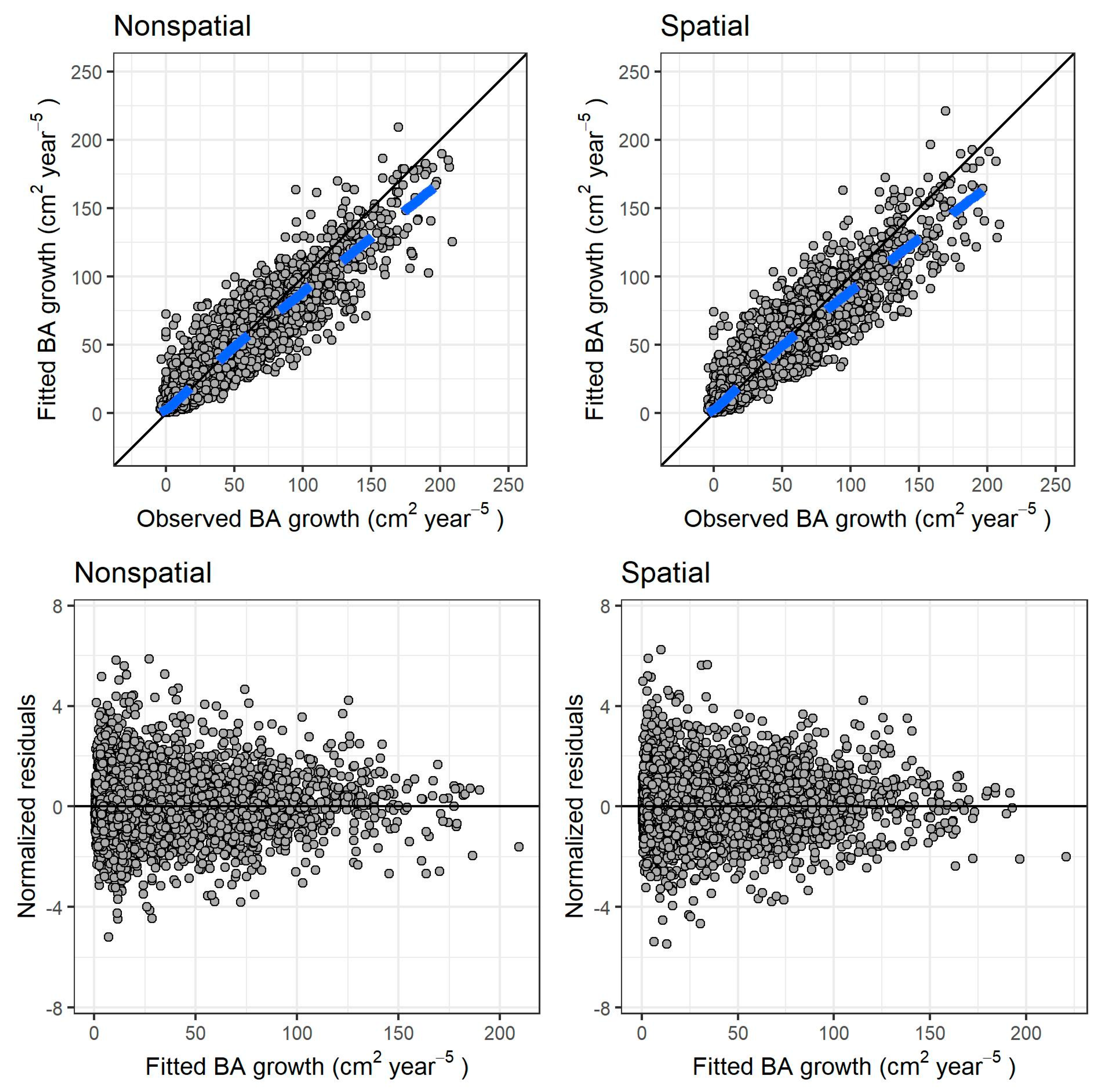
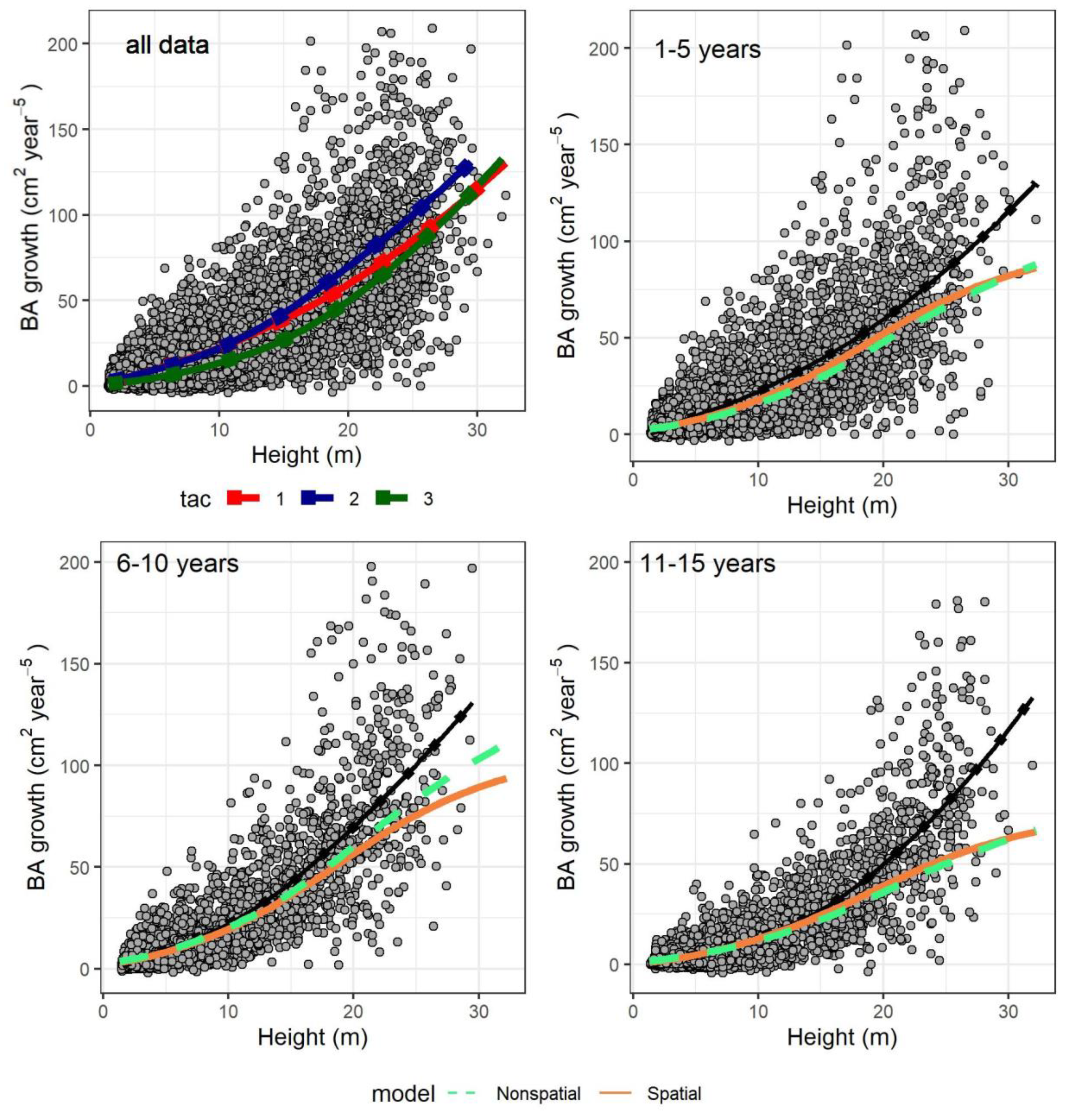
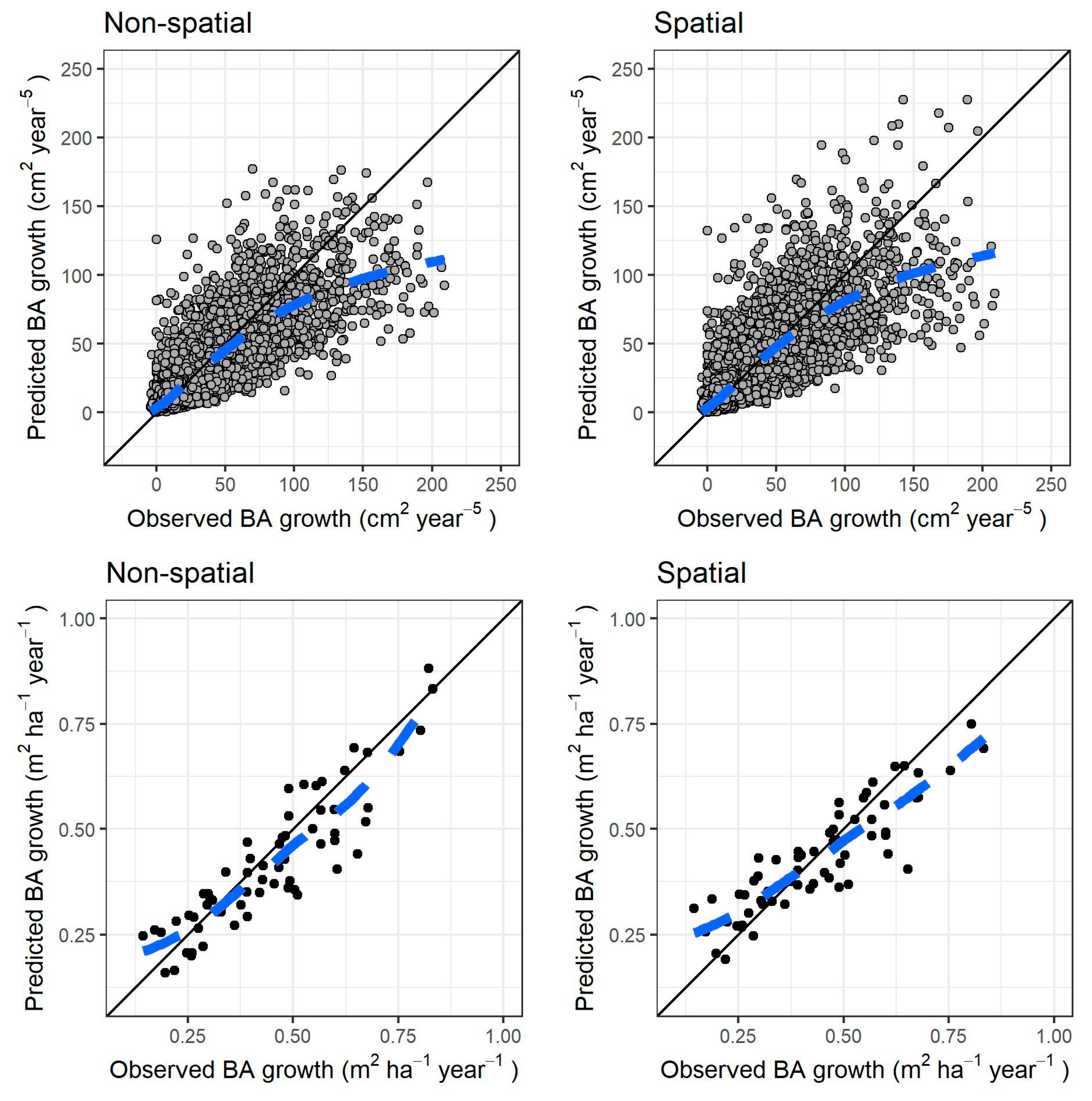
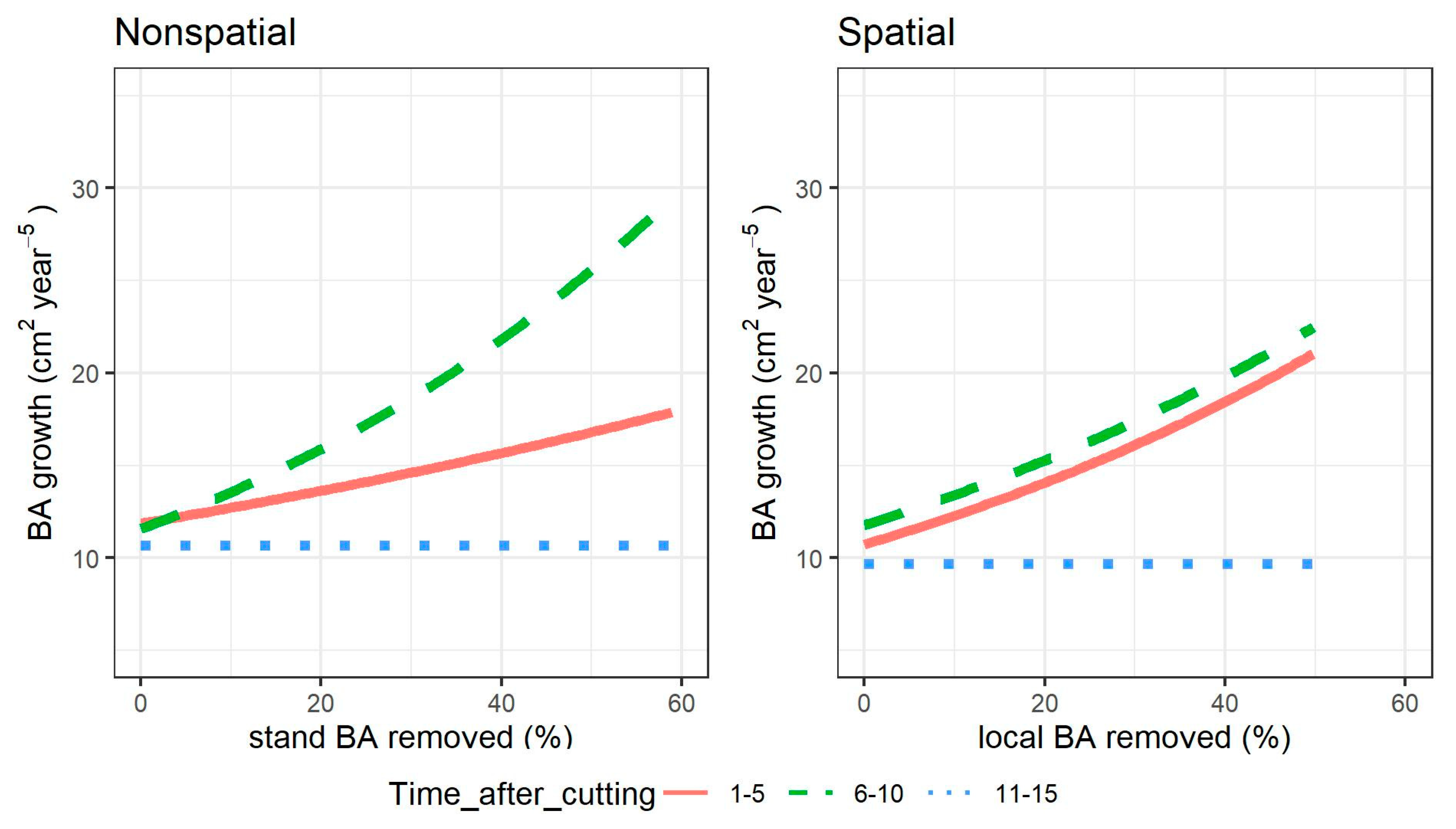
| Dataset | Number | ||
|---|---|---|---|
| Number of plots | 20 | ||
| Number of trees | 3547 | ||
| Number of growth measurements | 10,238 | ||
| Stand data | min | median | max |
| Mean height, basal area weighted (m), stand level | 16.30 | 19.30 | 25.50 |
| Stems per hectare (n), stand level | 538 | 1575 | 3619 |
| Basal area (m2 ha−1), stand level | 9.19 | 18.95 | 32.84 |
| Total height of all trees (km ha−1), stand level | 5.55 | 13.49 | 20.25 |
| Total height of all trees (km ha−1), local neighborhoods (300 m2) | 3.19 | 14.90 | 31.16 |
| Total height of all trees taller than subject tree (km ha−1), stand level | 0 | 9.83 | 19.82 |
| Hegyi index calculated for height, local neighborhoods (200 m2) | 0.13 | 8.05 | 68.64 |
| Basal area removed during cutting (%), stand level | 0.13 | 0.27 | 0.59 |
| Basal area removed during cutting (%), local neighborhoods (200 m2) | 0 | 0.19 | 0.50 |
| Mean annual increment (m2 ha−1 year−1) | 0.23 | 0.56 | 0.80 |
| Standard deviation of height distribution, stand level | 5.64 | 6.87 | 10.15 |
| Gini diversity index for height, local neighborhoods (100 m2) | 0.33 | 0.44 | 0.56 |
| Tree data | min | median | max |
| Diameter (cm) | 1.05 | 7.05 | 49.95 |
| Height (m) | 1.40 | 6.50 | 32.2 |
| Live crown ratio | 0.05 | 0.67 | 0.98 |
| Basal area growth (cm2 year−5) | −4.19 | 10.4 | 209.07 |
| Index | Evenness | Spatial Dependence |
|---|---|---|
| Total basal area (batot, m2 ha−1) | symmetric | nonspatial & spatial (local neighborhoods) |
| Total height of trees (htot, km ha−1) | ||
| Basal area of larger trees (bal, m2 ha−1) | asymmetric | non-spatial & spatial (local neighborhoods) |
| Height of taller trees (htal, km ha−1) | ||
| Hegyi’s competition index for diameter (hegyiD) and for height (hegyiH) | asymmetric | spatial (local neighborhoods) |
| Area potentially available, standard Voronoi polygons (apa, m2) | symmetric | spatial (fixed) |
| Area potentially available, Voronoi polygons weighted for diameter (apaw.d, m2) and for height (apaw.h, m2) | asymmetric | spatial (fixed) |
| Nonspatial | Spatial | |||
|---|---|---|---|---|
| Parameter | Value | Std. Error | Value | Std. Error |
| b1 | 0.11486 | 0.00688 | 0.18073 | 0.00546 |
| b2 | −1.46631 | 0.19220 | −2.75815 | 0.17771 |
| b3 | 1.98195 | 0.06214 | 1.71348 | 0.06099 |
| b4 | −0.02246 | 0.00423 | −0.04018 | 0.00234 |
| b5 | −0.18687 | 0.00914 | −0.02532 | 0.00139 |
| b6 | 0.69657 | 0.04096 | 1.35389 | 0.03716 |
| b7 | 1.58766 | 0.05023 | 1.29873 | 0.04539 |
| b8 | −0.36905 | 0.07901 | −1.16805 | 0.06132 |
| b9 | 1.61820 | 0.18853 | 1.09708 | 0.13946 |
| b10 | 0.03160 | 0.00895 | 0.46179 | 0.08486 |
| Random effect | St. Dev | St. Dev | ||
| Plot level | 0.155 | 0.171 | ||
| Tree level | 0.258 | 0.285 | ||
| AIC | 68,409 | 67,708 | ||
| Validation | Auto | Cross | Auto | Cross |
| RMSE | 9.42 | 15.58 | 9.40 | 16.03 |
| MAB | 5.59 | 8.89 | 5.37 | 8.88 |
Publisher’s Note: MDPI stays neutral with regard to jurisdictional claims in published maps and institutional affiliations. |
© 2020 by the authors. Licensee MDPI, Basel, Switzerland. This article is an open access article distributed under the terms and conditions of the Creative Commons Attribution (CC BY) license (http://creativecommons.org/licenses/by/4.0/).
Share and Cite
Bianchi, S.; Myllymaki, M.; Siipilehto, J.; Salminen, H.; Hynynen, J.; Valkonen, S. Comparison of Spatially and Nonspatially Explicit Nonlinear Mixed Effects Models for Norway Spruce Individual Tree Growth under Single-Tree Selection. Forests 2020, 11, 1338. https://doi.org/10.3390/f11121338
Bianchi S, Myllymaki M, Siipilehto J, Salminen H, Hynynen J, Valkonen S. Comparison of Spatially and Nonspatially Explicit Nonlinear Mixed Effects Models for Norway Spruce Individual Tree Growth under Single-Tree Selection. Forests. 2020; 11(12):1338. https://doi.org/10.3390/f11121338
Chicago/Turabian StyleBianchi, Simone, Mari Myllymaki, Jouni Siipilehto, Hannu Salminen, Jari Hynynen, and Sauli Valkonen. 2020. "Comparison of Spatially and Nonspatially Explicit Nonlinear Mixed Effects Models for Norway Spruce Individual Tree Growth under Single-Tree Selection" Forests 11, no. 12: 1338. https://doi.org/10.3390/f11121338
APA StyleBianchi, S., Myllymaki, M., Siipilehto, J., Salminen, H., Hynynen, J., & Valkonen, S. (2020). Comparison of Spatially and Nonspatially Explicit Nonlinear Mixed Effects Models for Norway Spruce Individual Tree Growth under Single-Tree Selection. Forests, 11(12), 1338. https://doi.org/10.3390/f11121338





